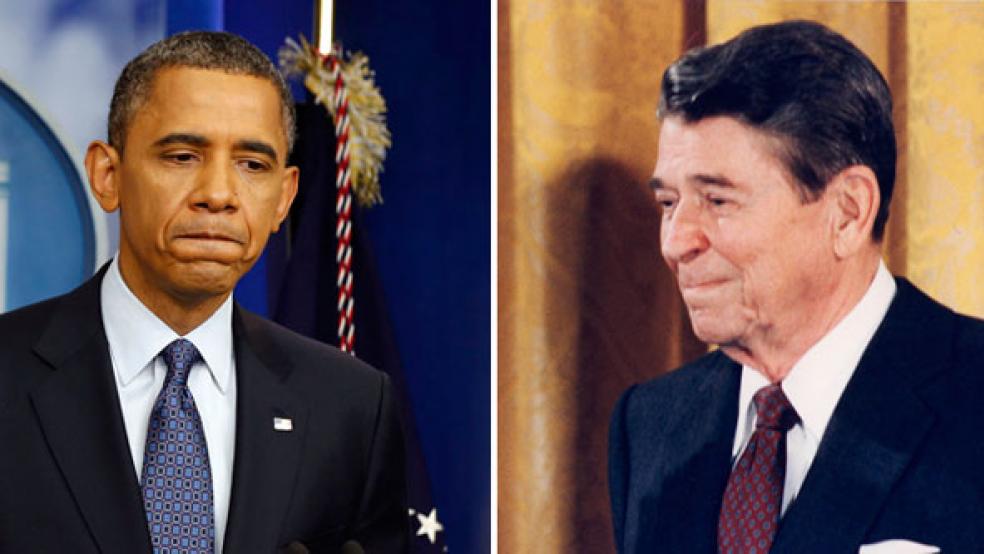A constant refrain of Democrats and Republicans alike in seeking to broaden their appeal to middle-class voters is that for far too long millions of Americans have been saddled with stagnant wages.
Last month, for example, the White House Council of Economic Advisers declared in a report that while job growth rose faster last year than in 2013, modest wage gains “cannot make up for decades of sub-par middle class income growth.”
Related: Obama’s Budget Strategy Taxes the Rich to Give to the Middle Class
However, a new paper by economist Robert Shapiro posted last week by the Brookings Institution sharply contradicts the conventional wisdom that middle class households have perpetually been victimized by sluggish income.
By mining new Census Bureau statistics that report household income by age, Shapiro discovered that growth in family income for average Americans was “broad and robust” throughout the administrations of presidents Ronald Reagan and Bill Clinton, but then abruptly stopped during the eras of George W. Bush and Barack Obama. This focus on changing income patterns of different age groups over time was a far less “messy” way of measuring aggregate median income than, for example, examining all households from teen years to 64, he explained.
Among Shapiro’s main findings:
- Throughout the Reagan and Clinton eras, nearly every type of household saw large, steady income gains. That held true whether the households were headed by men or women, by blacks, whites or Hispanics, or by people with high school diplomas or college degrees.
- This broad income progress came to a screeching halt around the turn of the century. Between 2002 and 2013, the incomes of most households “stagnated or declined even as they aged through nine years of expansion and two years of recession.”
- The only types of households that showed rising incomes over this more recent period were those headed by those in their mid-to-late 20s and college graduates, although their gains proved to be much smaller than those achieved by young and college educated households in the 1980s and 1990s.
Related: Why Middle Class Tax Relief Is Taking Center Stage
In short, Shapiro, a business executive and faculty member of Georgetown University’s McDonough School of Business, concludes that the income problems that most households face today “are not a long-standing feature of the American economy but rather reflect the particular condition and policies of the last decade or so.”

Shapiro identifies two main structural causes for the dramatic change in the income trends over the last 15 years. One is the effects of globalization and the other is the explosion in information technologies. Both of these seismic changes in the economy contributed to corporate downsizing and a far more competitive job market in the U.S., as well as downward pressure on wages.
The findings cast a revealing new light on the on the long-term plight of the middle class and the profound impact that changing public policies in Washington can have on the average lives of Americans — or at least certain public policies.
“The broad and strong income progress achieved under the Clinton and Reagan presidencies may well suggest that the major differences in their economic policies, as in tax policy, did not greatly affect the income paths of most Americans,” Shapiro writes.
Related: Full Employment Alone Won’t Solve Problem of Stagnating Wages
What did help improve the incomes of American households, Shapiro suggests, were fiscal approaches under Reagan and Clinton that supported stronger rates of business investment. Those approaches included raising substantial new revenues and slowing the growth of certain areas of spending.
More specifically, Shapiro notes that Reagan and Clinton had made “public investments to modernize infrastructure, broaden access to education, and support basic research and development.” Those investments “promoted stronger overall growth and an increase in underlying productivity that lifted income in the latter 1990s.” These types of public investments shrank under Bush and Obama, a change that Shapiro said had “serious effects for both short-term growth and long-term income progress.”
Shapiro, who served as an economic adviser to Clinton in his 1992 campaign, also points to free-trade agreements under Reagan and Clinton as important measures that helped drive stronger economic growth.
Members of Congress and the Obama administration may find important lessons in Shapiro’s study as they debate a new budget and infrastructure program for the coming years.
Top Reads From the Fiscal Times:





